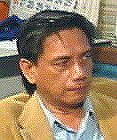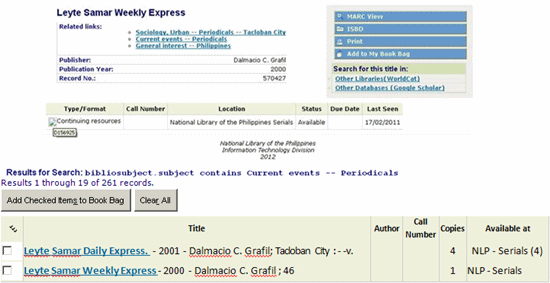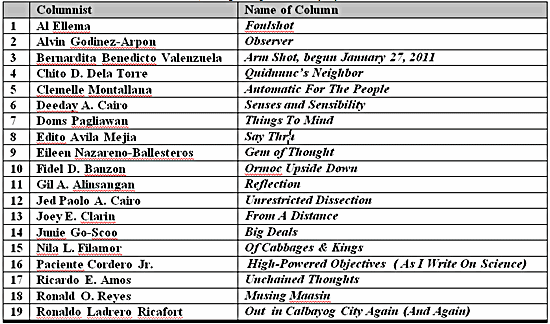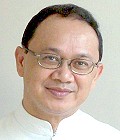The Express
Publications, completing a Silver Jubilee of media service
TOWARDS A GOLDEN ANNIVERSARY
25 YEARS HENCE
 By
CHITO D. DELA TORRE
By
CHITO D. DELA TORRE
December 22, 2012
Today, December 22, the
Leyte Samar Daily Express begins to navigate its next 365-day course
as a “positive, fair, and free” regional daily newspaper as it
commemorates the 25th year (a silver jubilee, indeed!) of the Leyte
Samar Express publishing industry in simple anniversary activities at
its main office, the first floor of the Knights of Columbus Building
along Padre Zamora street, Tacloban City.
As it does, the couple who
are behind this trademark of free journalism in the Waray Region,
Dalmacio “Massey” Candido Grafil and Alma nee Montallana, both from
the province of Eastern Samar, renew their commitment of continually
improving on their service of catering to the information needs of the
news reading public in Region VIII.
A solid proof to that
renewal is their having aptly prepared themselves, their personnel,
and their office for the rising challenges to the publishing industry.
On the mechanical aspect, they acquired and caused the installation
right at this office last October 28 two units of the latest brand of
printing equipment that can hasten newspaper production: one
platesetter and one plate processor. Just after about 3 minutes –
counted from the time the editorial content navigates to the “network”
until it gets its finished form on a plate – the latest issue for the
day of the Leyte Samar Daily Express is ready for printing. In the
next hour or so, the newspaper gets off the offset printing process,
ready for distribution to its different circulation outlets around the
region. Between 6 and 7 o’clock in the morning of each day, from
Monday to Sunday of each week, newsstands in Tacloban start selling
this newspaper. By the middle of last month, these two acquisitions,
having been commissioned to their fullest, produced their first print
form of this paper. The other preparations corresponded to these
innovative changes.
This attribute further
demonstrates the responsiveness of the editorial management. That is
why it continues to attract advertisers and newsmakers. In another
vein, it also helps prepare future journalists by enlisting interns
from among mass communications and media-related courses. Its
competent editorial force, themselves veteran journalists, headed by
editor-in-chief Vicente “Ven” S. Labro, who hails from Catbalogan,
Samar, provide the necessary guidance and mentoring (where needed) to
all their staff members, including interns, and others who wish to
work for the Leyte Samar Express publications.
Yes, publications, for aside
from the daily, the Express family has also been publishing weeklies
in the different parts of the region, with provincewide circulation,
apart from a city edition.
The Express newspapering
industry has kept on growing since its first newspaper publication,
the Leyte Samar Weekly Express which first hit the streets exactly on
December 22, 1988, less than two years after the Philippines regained
its democracy from a dictatorial regime. The LSWE, acronym for that
newspaper, became the mother of the weeklies subsequently published –
the first inside-page provincial edition having been the “Leyte Samar
Weekly Express Biliran Edition” under the editorship of community
organizer-NGO worker Socorro “Intoy” Cotejar of Naval (capital of
Biliran province) – until the birth in year 2001 of the Leyte Samar
Daily Express (LSDE, or Daily Express, for short), thanks to the
daring but encouraging idea of Emil Justimbaste who at once became its
first editor-in-chief.
During the days of the LSWE,
the Leyte Samar Express Newsmagazine was born, with this writer, while
serving as associate editor and columnist of the weekly, taking the
cudgel as editor-in-chief. The Newsmagazine continued until the daily
became the regular flagship publication of the Express family.
True to its social
obligation and duties, the Express family, notably the men and women
behind the LSDE, adhere to the avowed ethics and principles of
journalism and find active membership in such respectable media
organizations as the national Philippine Press Institute, and some
local groups, like the erstwhile and then defunct Leyte Private Media
Inc., and the popular, now 12 years old, Express It At The Park (EIATP)
which began with only four men – Massey himself, now LSDE columnist
Alvin G. Arpon, Emil, and engineer Wilson Chan, general manager of
Leyte Park Hotel. Other regional and provincial organizations, such as
the Philippine National Police Press Corps, Samar Island Press Club,
the Catbalogan Cable TV Media Nucleus (CCATMAN), Region Eight
Tri-Media Association (RETA), and other independent media groups.
Besides responding to requests for reportorial coverage (like those
from regional government agencies and local government units, and even
requesting militant sectors), or participating in building advocacy
lines as the media sector, the Express, specifically the LSDE, also
closely coordinates with the Philippine Information Agency. This
involvement accentuates the “positive”, or pro-active, character of
LSDE.
Among the pioneers in the
Express family, aside from Massey and Alma themselves, had been David
Genotiva, Loly Isiderio, Inocencio P. Maderazo, Atty. Aurelio D.
Menzon, and this writer.
LSDE in Directories
Leyte Samar Daily Express
appears in websites or blogs which present it as among those worth
simply posting or displaying or as part of a directory, or fit for the
“marketplace” (meaning, marketable).
In the National Library of
the Philippines, the Information Technology Division online public
access catalogue posts the following for year 2012 under the link
koha.nlp.gov.ph/cgi-bin/koha/opac-detail.pl?bib=570427 in the NLP
website:

From Sell123.org, tagging
LSDE as company/Philippines/889095.htm, a screenshot of the entry
says:

In the Philippine
Information Agency Region VIII website, via web.vis.net.ph where the
search link states “lineagencies/pia/index.php?option=com_content&task=view&id=22&Itemid=1”,
LSDE occupies the top space its “PA – VIII Daily News Reader”:

(The PIA is a Philippine
government agency with a regional office in Tacloban, the first and
only highly urbanized city in the Leyte-Samar-Biliran Waray Region.)
Here’s however a website
entry, which is not (italicized texts) entirely true, from
www.Tradezz.com, the LSDE being tag-linked as
corp_644788_Leyte-Samar-Daily.htm:

The LeyteSamarDaily.net
In its own website,
leytesamardaily.net, now, since 2011, finds a 3-column layout page
with the following sections available only a mouse click after, below
the date of posting:
On the left column – News
with photo, and reference titles (Categories) to what you may want to
read from the archives: ‘ANNOUNCEMENT’, Editorial, Letter (letters to
the editor), features, opinion columns, entertainment, message (such
as that of His Holiness Pope Benedict XVI for the 46th World
Communication Day, published on May 20, 2012), opinion columns, news
(banner [News 1] and second stories), Ulat Sa Bayan, and uncategorized
items;
The middle column is the
main display board for the referenced items. A click on a chosen item
leads to the full text of that item. Often it displays the top-billed
photograph, followed by an editorial cartoon, a lead to the “Second
Story”, and leads to the other articles. Opened after the Home page,
the following information is given at the bottom of the full-display
item: name of the writer (as tagline, if not mentioned in the
beginning of the article as a by-line) or the source, date at which
the item is published in the net page, guide as to where the item is
found, and a folio on the “previous topic” and “next topic”. A
feedback section is found at the bottom of the column, in which a net
reader can write reactions or mere thoughts related to the item found
in the upper section of the column, or to any other item accessed via
this net page; and
On the right column – In the
Home page, one finds leads to Opinion (often with photos of
columnists, followed by a summary lead to News 1 and then leads to
More news1 Headlines. The anchor section sometimes gives leads to the
Feature stories, and titles of articles that are presently “Trending”
(which also indicates how many are reading or have read each trending
article), while the bottom liner gives exactly what number are you
presently among those visiting the LSD net. Browsed, the net page next
ushers your to a poll survey (today the survey is on the question “How
often you visitLeyteSamarDaily.net” [then as you browse, the inside
survey question faces you: “How did you find LeyteSamaDaily.net”],
while for a longer time in the past, it was about rating the water
service in Tacloban) which elicits reader’s participation, then it
gives you the FaceBook “Like” pluggers, the “Live Traffic Feed” (a
real-time view with menu) showing who reads what item and from which
point of the globe, Latest Topics, and Recent Comments.
Here’s a screen shot of the
“Trending” on the home page for December 19, 2011, as of 6:14 p.m.:
 Fair
Newspaper
Fair
Newspaper
The region’s one and only
daily newspaper, that the Leyte Samar Daily Express still is,
demonstrates its adherence principle of fair reporting, or fair
journalism. Publisher Massey Grafil sincerely and deeply views it
likewise as an obligation on the part of both the newspaper itself and
its writers. Thus, it gives space to all those who feel they are
affected by any item it publishes, except in the case of opinion
columns, where, as established and sustained by legal jurisprudence
and clipped up by editorial newsrooms, the contents and claims therein
remain the sole and full responsibility of the opinion column writer.
Even then, here, where some parties are affected, columnists get up to
that level of being able to provide clarifications especially when
their claimed “sources” are challenged”.
Examples of how LSDE
responds to this obligation, when not available during newsgathering
and editing (which actually includes “crosschecking for accuracy” – as
I always emphasized in my lectures on news writing since 1975 to
various audiences [high school and college students, community
information officers, professionals, advisers of school or campus
writers, fellow journalists, and government information officers]),
are these references to letters to the publisher: denials and/or
rectifications to allegations in a news item written by Alvin P.
Cardines concerning the performance of nursing schools in the nursing
board exams, sent in by ESSII/OIC, chief administrative officer
Marcelo M. Uy of the Commission on Higher Education (letter dated
March 2, 2011), Naval State University president III doctor of
education Edita S. Genson, and Professional Regulation Commission
regional director German P. Palabyab (the last two letters published
on March 4, 2011). The effort on fairness went so far as to include
this down-to-earth statement by Palabyab: “.... May I suggest next
time; your prestigious newspaper should send me an experienced
reporter, instead of a cub reporter who conducts his interview on the
phone only. A more matured and experienced writer might have a
different report. Your reporter by the way came to see me and claimed
that his original manuscript was changed by your editor.” (Alvin
called Marcelo on February 28, 2011 and the latter “stated that the
CHED Regional Office has no data available regarding the issue ....
did not identify any school” and told Alvin that his position was
“OIC, Chief Administrative Officer” (not CHED OIC).
Growth and Acceptance
The preponderance of opinion
column writers in a newspaper is in a way an indication of a
newspaper’s growth and acceptance, gauging likewise the potential
number of “followers” each columnist has anywhere in the world.
As of today, as could be
gleaned from the LSDE net pages, this daily newspaper is endorsed by a
total of regular columnists (otherwise, they would not anymore be
writing for LSDE and their columns will no longer see print). The 19
names of columns and columnists are as follows (arranged
alphabetically by writer’s name:

Behind the regular
“Commentary” are the opinions of Fr. Roy Cimagala and the veteran
national journalist Juan Mercado who writes with depth and historical
insights.
There had been other
columnists, editors, staff writers, and regular contributors (either
as reporters or free lance writers) to both the LSDE and its sister
publications, as well as in the harbinger Leyte Samar Weekly Express.
The coming innovations will
certainly see more coming in. Region VIII certainly likes that.
Murder is murder,
not a 'legitimate encounter'
A Statement from the Asian Human
Rights Commission
December 21, 2012
On December 19, the
Commission on Human Rights (CHR) was reported to have concluded after
over two years of investigation that the killing of botanist Leonard
Co and his two assistants in Leyte in November 2010 "was due to the
military's failure to distinguish civilians from combatants." The CHR
has submitted its report to the Department of Justice (DoJ) but did
not make recommendations on as to what criminal charges should be
filed against the soldiers involved in the operation and killings. The
CHR has left it to the DoJ to "determine what charges will be filed."
The AHRC welcomes the CHR's
report though it is of the opinion that it could have been resolved
more promptly. The AHRC feels that the publication of the report is
long overdue and rejects the CHR's inability to conclude what charges
should be filed against the soldiers. Killings on the pretext of
'legitimate encounter' are very common in remote areas when soldiers
conduct military operations and the justification of killings as
'legitimate encounters' has been the convenient excuse used by the
soldiers and the police to escape criminal liability.
The AHRC strongly believes
that the killing of Leonardo Co and his two assistants was not due to
the "military's failure to distinguish civilians from combatants," but
rather a 'premeditated murder'. This judgement is based on the
numerous cases of killings on the pretext of 'legitimate encounter'
which were later found to be murders. Unless the CHR categorically
concludes and recommends to the DoJ to prosecute the soldiers for
murder, the soldiers and the policemen will continue to use
'legitimate encounter' as the justification for their 'widespread and
systematic' killing of civilians.
Operations conducted by the
Armed Forces of the Philippines (AFP), including the operation that
killed Leonardo Co and his aides, in fighting against the communist
and the separatist insurgencies are thoroughly planned. The soldiers
have deeply embedded intelligence networks in these communities and
are fully aware about who and what is going on. In fact, it is very
common for the soldiers and the police to keep records of people who
live in the villages, those who come and go because most of these
villages are under curfew and hamletting, which is the collection of
villages under military control.
In view of this to claim
that these soldiers would go on military operations proceeding to
areas under their complete control not knowing who the people in the
communities are is to deny reality. In fact, to know or not whether
the victims were civilians is irrelevant in Co's case. Ms. Loretta
Rosales, chairperson of the CHR, herself has said: "The truth is,
there was no legitimate encounter because it was one-sided, there was
no exchange of fire."
Apart from the killing of Co
and his aides, local human rights organisations have since documented
numerous cases of killings on the pretext of 'legitimate encounter."
Of late is the massacre of the Capion family on October 18 this year
in Tampakan, South Cotabato. In our 2012 Human Rights report (p. 10)
we have concluded that;
"To justify civilian deaths
in massacres as 'legitimate encounter' is common practice by soldiers.
They are able to escape scrutiny because of practical difficulty for
the police to effectively and impartially investigate these cases in
their remote sites of occurrence. Before the Ombudsman resolved to
indict soldiers for the death of Bacar Japalali and his pregnant wife
Carmen in September 2004, the deaths were also justified as a
'legitimate encounter'. The Ombudsman, however, rejected the soldiers'
claim, because the bodies of the couple were still inside the mosquito
net when found. The soldiers also portrayed the couple as members of a
Muslim rebel group in an attempt to discredit them and to escape
criminal liability. However, investigation by the prosecutors and the
police revealed the couple had nothing to do with armed rebellion.
The AHRC strongly recommends
to the CHR and the DoJ to prosecute soldiers and policemen, not only
in Co's case, but in many other cases where the killings of civilians
have been justified as a 'legitimate encounter' on charges of murder.
It is the utmost responsibility of the CHR and the DoJ to make it
clear to the authorities and the public that murder is murder, not
'legitimate encounter'. It must be made clear to the military and the
police establishments that they will be held accountable for murder in
order to end this practice.
Truths behind the
RH bill
 By
Fr.
ROY CIMAGALA, roycimagala@gmail.com
By
Fr.
ROY CIMAGALA, roycimagala@gmail.com
December 16, 2012
There’s a little, handy
booklet entitled, Handbook of truths behind the RH Bill, which I think
is good to have for the campaign to clarify this delicate issue that
is now swamped with all sorts of confusing arguments.
It focuses more on the
medical, economic, demographic and legal aspects of the issue rather
than on its morality. And so, it is good for those who want to reach
out to those who are a bit allergic to religious arguments but are
more open to its more secular, scientific or empirical perspectives.
I, of course, believe that
the issue is first of all moral – the reason why the Church is very
much involved in it – before it is a medical, economic or legal issue.
But since people have different sensitivities and attitudes, it would
be good if they too can get hold of some clarificatory materials that
satisfies their preferences. This handbook does that.
First of all, I wish to say
that our first freedom, the most intimate freedom we have is religious
freedom, on which is based our sense of morality, among other things.
It is not freedom of speech and assembly, nor even freedom to live,
since all these rights and freedom are based on our religious freedom.
I feel urged to make that
clarification because when I read the arguments used by some of our
congressmen who voted on the issue in the second reading, I now
understand why many of them took what I consider as wrong positions
regarding the issue.
Their idea of our first and
ultimate freedom can be reduced to freedom to be oneself, as expressed
in some allegedly absolute freedom to life, expression and assembly,
right to liberty, etc.
To me, it sounds like a
freedom that does not talk about where it came from and how it used to
be exercised. It is presumed to be self-generated or spontaneously
created that in the end is like saying that we too in our life, in our
very being are self-generated and spontaneously created. That’s, of
course, a ridiculous presupposition.
In short, they are saying
that there is no creator for us. There is no God. This is a form of
atheism that may be considered as practical atheism, not so much the
theoretical one, since it may not be formally professed but is simply
practically and consistently lived.
This, I think, is a point
that needs to be ventilated more widely, since this is not yet fully
appreciated by many. That’s why we have an understanding of democracy,
supposedly based on freedom, that is actually weak and vulnerable to
be exploited by those who have power in one form or another.
Going back to the handbook,
it is a well-written piece by a team of experts in the area of
economics, demography, education and law. It takes the issue to its
deeper and wider implications, exposing the hidden but clear maneuvers
of powerful groups and ideologies averse to supernatural faith and
religion in general.
It is written by competent
authors who are very much into the intricacies of this issue. They are
Dr. Bernardo Villegas, economist; Miss Rosa Linda Valenzona,
demographer; Jo Imbong, lawyer; Roberto de Vera, economist; Raul Nidoy,
educator; and Robert Cortes, educator.
Among the points taken up
and developed, supported by relevant studies and researches, are the
following:
-The RH bill is harmful to
the Filipinos because it endorses drugs and other family planning
supplies and techniques that have serious deleterious effects to their
physical health and to the environment.
-Pills and the IUD kill the
human embryo.
-Pills cause serious
environmental problems.
-The RH bill is harmful to
Filipino society because its intent to control population is based on
wrong facts and wrong economics, and naive to the negative social
effects that will come in its train.
-It implies that a rapidly
growing population causes hunger and shortage of resources. It does
NOT.
-It neglects the fact that
societies that have aggressively pushed for contraception are now
suffering from a “demographic winter.”
-The RH bill is harmful to
Filipino society because it violates the Philippine Constitution and
seeks to enshrine into law forced and artificial ‘rights’ that may
even threaten more basic and genuine human rights.
Let’s hope that this
handbook can contribute to a more meaningful discussion and dialogue
with everyone regarding the issue. We need to be open-minded but clear
about our views and positions that are supposed to be grounded on
well-established principles and assumptions.
Let’s hope that this
dialogue continues and leads us to its proper end.
Religion has
nothing to do with Pacquiao's fall
 By ALEX P. VIDAL / PNS
By ALEX P. VIDAL / PNS
December 12, 2012
If it is true that “God
punished” Manny Pacquiao supposedly for converting from Roman Catholic
to “born again” Christian, then God is not just; He is cruel and He
plays favorites.
Since most of us believe
that God is pure love in its most supreme form, He could not have
guided Juan Manuel Marquez’s lethal right to inflict harm on a
faithful follower.
God has laid down from all
eternity the law which governs all things, like light from the sun;
but He will never change the economy of world boxing for Marquez who
is a Roman Catholic.
What happened to Pacquiao
also happened to other great marquee names such as Muslim convert
Muhammad Ali, Mike Tyson, Lennox Lewis, Roberto Duran, Tomas Hearns,
Sugar Ray Leonard, and to the now Rev. George Foreman.
Single Blow
When all these rings titans
were felled with one single blow in high profile fights, nobody blamed
God or their conversion to any faith for their Waterloo.
Ali (56-5, 37 KOs), formerly
Cassius Clay, converted from Christian to Muslim after winning the
world heavyweight crown from Sonny Liston on February 25, 1964. As a
Muslim, he racked up 10 straight wins before losing by unanimous
decision to Joe Frazier for the world heavyweight championship on
March 8, 1971 in New York.
In this defeat to Frazier
(32-4, 27 KOs), Ali was floored with a single punch and nearly
suffered a knockout loss but managed to finish the fight scheduled for
15 rounds. Nobody blamed his shocking loss for his decision to embrace
Allah.
Before he became a pastor,
Foreman suffered a humiliating 8th round technical knockout defeat to
Muslim Ali on October 30, 1974 in Zaire. In this epic war dubbed
“Rumble in the Jungle,” the Christian God and Allah did not intervene
to save their respective “bets.”
Muslim
Another Muslim fighter Hasim
Rahman (50-8, 41 KOs) made headlines all over the globe when he scored
a major upset in the heavyweight division with a one-punch knockout
win over previously indestructible Brition Lennox Lewis (41-2, 32 KOs)
at the Carnival City, Brakpan, Gauteng, South Africa on April 22,
2001. Again, nobody credited Allah for Rahman’s extra-ordinary power
that night. Nobody blamed Lewis for missing his “duties and
obligations” as Christian Anglican faithful.
The distinction between
religion and superstition is fundamental in the fall of Pacquiao.
Voltaire, in his magnificent
prayer, once addressed to God in the article “Theist” where he
expounded his faith finally and clearly: “The theist is a man firmly
persuaded of the existence of a supreme being as good as he is
powerful, who has formed all things; who punishes, without cruelty,
all crimes, and recompenses with goodness all virtuous
actions…Reunited in the principle with the rest of the universe, he
does not join any of the sects which all contradict one another. His
religion is the most ancient and the most widespread; for the simple
worship of a God preceded all the systems of the world.”
Strong rights, no
remedy
A
Statement by the Asian Human Rights Commission on the occasion of the
Human Rights Day 2012
December 11, 2012
The Asian Human Rights
Commission (AHRC) has released its 15-page report on the situation of
human rights in the Philippines this year. The report, titled "Strong
rights, no remedy," gave detailed analysis on the absence, if not lack
of adequate remedy and redress to any forms of violation of rights in
the country's system of justice. The report is written in seven
sections and each section gives analyses of the important events which
took place this year, and by examining old cases and new cases it has
documented, it evaluates what impact it has had on protection of
rights.
The discourse on protection
of rights, or the lack of it, in the Philippines has been very
challenging in recent past. There is a strong perception -- domestically
and internationally -- of the governments political will to protect
rights. But whether their public statements and policy of protection
of rights are translated into reality to the daily lives of the people
who suffer have been questionable. There are rights, like freedom from
torture, with no legal remedy in the past, now they have; perpetrators
of gross human rights violations, like former president Gloria Arroyo
and the military generals during her term, who could not be prosecuted
in the past, are now being prosecuted.
The government has been
engaged in legislating and ratifying domestic and international human
rights treaties respectively, but in practice none of those accused of
torture have been punished. Events and developments like this have
resulted to renewed confidence on the government. By examining
empirical cases, it is clear that there is a fundamental breakdown in
the country's system of protection as described below.
Convicted chief justice &
the court judges
This section examines the
impact of the conviction of Renato Corona, former chief justice of the
Supreme Court (SC) in an impeachment trial for his non-disclosure of
his assets, on the discourse of judicial accountability and corruption
amongst the judges in the lower courts all over the country. Corona's
conviction has restored the confidence of the public on the executive
and legislative for exercising their role as co-equal branches in
safeguarding corrupt practices and abuses.
But Corona could be
impeached and punished; however, in practice judges in lower courts
subordinate to him breached due process rules and fundamental
principles of fair trial as they exercise of their duty daily. Judges
ignoring orders by the SC, admitting evidence taken by way of forced
confession and torture, conniving with prosecutors in fabricating
charges against human rights and political activists, delaying trial
of cases, and others subverting due process is very common. They were
never punished.
Old and new cases: no
arrest, remedy
This section explains why
the Inter-Agency Committee on Extra-Legal Killings, Enforced
Disappearances, Torture and Other Grave Violations of the Right to
Life, Liberty, and Security of Persons, which President Benigno Aquino
III, is doomed to fail. This body, with a fresh mandate to investigate
old and new cases, only repeats the ritual of creating task forces and
special investigation bodies.
The inability and failure of
similar special task forces before, notably the Task Force 211 in
November 2007, to ensure that its prosecution based on the special
investigation they earlier had conducted would result to conviction,
identification of the accused and conclusion of cases, questions the
competence and credibility to this new 'super body'. Also, the
inability of the authorities to arrest former General Jovito Palparan
and his accomplices for the enforced disappearance of activists
despite the increases reward money for his arrest clearly illustrates
that even if court issues arrest orders, perpetrators would not
arrested.
If Palparan and other
powerful and influential politicians, who had been identified as
masterminding targeted attacks of human rights and political activists
in high profile case could not be arrested despite being known in the
country, it means the possibility of prosecuting perpetrators of
extrajudicial killings and disappearances where the perpetrators are
not identified--like the death squad in Davao City – is non-existent.
Thus, the recommendation of the Commission on Human Rights (CHR) to
hold local officials accountable in Davao City would be meaningless.
Cycle of rights violations:
massacre, killings, torture & disappearance
As expected, massacres and
other forms of horrible violations happened this year, too. But these
cases are no different to earlier documented cases that remain
unresolved. If the perpetrators in the Maguindanao massacre in
November 2009, after three years of trial, are still unpunished and
other perpetrators remain at large, it would not be surprising that
the massacre that documented this year, notably that of Capion family
in October 18 in Tampakan, South Cotabato, would not be resolved, too.
One of the complainants in
the case of the Maguindanao massacre, Myrna Reblando, widow of
journalist Alejandro 'Bong' Reblando, had to leave the country for
lack of adequate protection. Not only her that is being targeted,
there have been potential witnesses who had been killed before they
could testify, families of the victims offered bribe, if not being
continuously being the object of threats and harassment with the
deliberate intent for them to withdraw their complaint. They have no
protection.
No remedy, redress: they be
Filipinos or not
In the past, there are
probabilities of prompt and effective intervention when foreign
governments and their people take action from abroad on human rights
issues. In this section it explains that even in cases of foreign
nationals, Wilhelm Geertman and Fr. Fausto "Pops" Tentorio who were
murdered on July 3, 2012 and October 17, 2011 in the country
respectively, perpetrators are either unpunished or unidentified.
Wilhelm and Fr. Fausto had
lived and worked for decades with the poor and vulnerable communities.
If cases of these persons, who has representation from their foreign
governments and pressures from their own people back home had not
resulted to adequate remedy, will cases of Filipinos in their own
country have? This section demonstrates numerous cases without
remedies regardless of the identity and personal background of the
victims. No remedy be they Filipino or not.
Prospects in the emerging
justice system: Bangsamoro political entity
The signing of agreement
between the Moro Islamic Liberation Front (MILF) and the Government on
"Framework Agreement on the Bangsamoro" offers prospects of peace and
building of democratic institutions that would address the aspirations
of the struggle of the Muslims in the south. The real challenge is how
to build institutions of justice that would address the grievance of
the Muslims who are often the usual suspects in terrorist activities
after decades of subjugation.
This section draws the old
experience on how cases of torture, arbitrary detention and
fabrication of charges, had been committed with the operation of
justice system – the police, prosecutors and judiciary. These lessons
should be learned. Thus, it is important that fair trial and due
process is to be fundamental values in this emerging justice
institution in the proposed political entity if this agreement for
political settlement on the Mindanao question is to survive.
Rights in the Philippines:
on paper, not in practice
This section explains that
by its legislation of domestic law and ratifying international human
rights treaties, the government succeeded in making it appear on paper
that not only it has 'political will' it is also a 'champion of human
rights.' The perception it has created and 'diplomatic victory' is has
obtained in doing so, has changed the landscaped of human rights
discourse into becoming even more difficult. The government's records
is being reviewed, not how in reality it afforded or not afforded
remedy to violations of rights, but how many domestic laws, human
rights treaties it has signed; and public statements of its government
officials reaffirming protection of rights.
In conclusion, it is clear
that without changes as to how the institutions of justice – police,
prosecution and the judiciary – operate to ensure adequate protection
of rights, there is no possibility that rights on paper would have
remedy. If the very fabric of the system of protection of rights is
flawed, no rights would have the possibility of obtaining any
remedies.
This report is available at
http://www.humanrights.asia/resources/hrreport/2012/ahrc-spr-009-2012.pdf/view